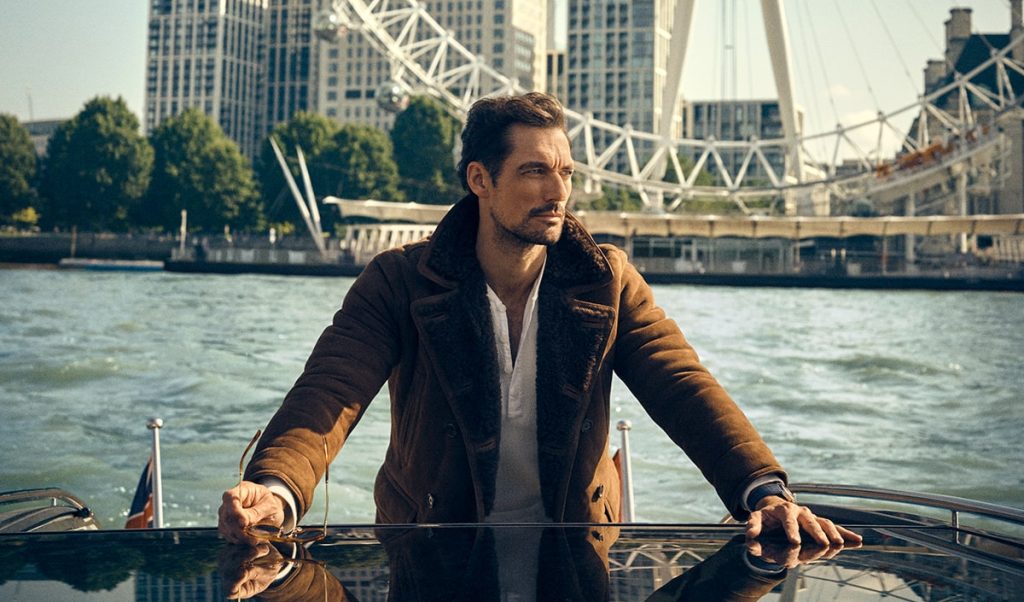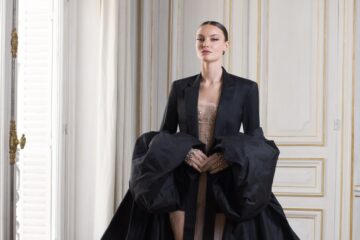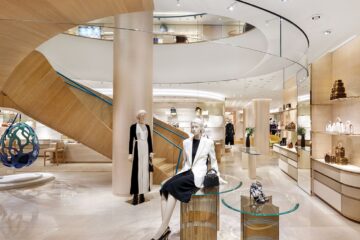David Gandy Wears It Well
After 20 years reigning supreme over the male modelling world, David Gandy launches his own casualwear brand, Wellwear.
David Gandy is one of the few male models with his own book. A beautiful (obviously) coffee-table book done in collaboration with Dolce & Gabbana. He was also the only male model representing Britain at the London Olympics. And, of course, he’s ridiculously good-looking. But that didn’t prevent Gandy from having to take time off during the lockdown at his countryside home in Britain. At 41 years old, Gandy is entering a new phase of his career, launching his own fashion brand, Wellwear. And that’s not all he does. Cars, architecture, clothing — David Gandy has many refined interests, with one common thread running through them all: style. He’s also the father of a three-year-old girl with his partner, barrister Stephanie Mendoros, and a month after this interview was conducted, they welcomed a second daughter. We couldn’t pass up the opportunity to discuss the many endeavours of this renowned supermodel.
Q: Did your family dress up when you were growing up?
A: My grandfather would come for Sunday-afternoon lunch and he would always have a tie on. None of my family came from a wealthy background, so they never had money. They didn’t have disposable money, so everything had to last. My dad had good suits. Not name suits, not branded suits, but good suits. They would always have Windsor ties, tied perfectly. They weren’t expensive, but everything fitted well. All those things have crept into me when I’m doing my own brand. It has to be quality, it has to last a long time, it has to be a comfortable fit, it has to be right. It still has to be stylish, but it has to be attainable. We call it a “lifestyle brand,” because that’s what I am. I’m very fortunate to have been given the “stylish man of the year” award. That’s style, that’s not fashion. That’s a lifestyle. People see the classic cars, the house renovations, the tailoring, the jeans, the T-shirts — that’s just me, that’s not a stylist who does that. I’ve never had a personal stylist. It’s selling the whole ideal. Just like Ralph Lauren — you’re selling the lifestyle, with the dogs, the polo, the watches, etc.
Q: You went to college, which not all models do since many start their career early. I imagine modelling wasn’t necessarily seen as a viable career choice at the time. Was it a rebellious decision to pursue that career?
A: There was one thing I learned at university, and that’s that I shouldn’t have gone to university. It was the biggest waste of time of anything I’ve ever done in my life. That’s the honest truth. I wanted to progress and see the world. It wasn’t for me. When I came to the fashion world, I didn’t get Dolce until five years into my career. I absolutely adore travelling. That may scare a lot of people. A lot of people want to be at home, have a routine, a wage, know when they’ll go on holiday. My routine is, there isn’t one. You don’t know what you’ll be doing from one day to the next. It’s calmed down now, but for 20 years, I didn’t know where the next wage was going to come from. You could be on a plane tomorrow. You could be on a plane next week … or you could be on five planes next week. And that was the excitement for me. So, it wasn’t rebellion; it was a way of discovering the excitement of life.
Q: You’re a pretty organized guy, mapping out where you want to be, doing five-year plans. COVID-19 must’ve been hard for you. Do you owe some of your success to being well organized?
A: When I got my start in the business, I observed. I was fortunate enough to work with people like Christy Turlington and Naomi Campbell, and I thought, What are they doing differently that the male models are not doing, to reach that plateau that we can’t reach? They had PRs, they had managers. It was because the supermodels ran it as a business. And any business needs to be organized. I am organized and run it as a business. There are strategies, and there are plans. It’s different, very difficult, in this industry, to plan where you’re going to be and what you’re going to do, and that’s where plans come through. You need to have a goal. If you don’t have a goal, you won’t know where you’re going. I plan everything. I look 10 steps ahead of everything to see the dangers and where things could go wrong and have solutions ready before things even go wrong. Hopefully, they never do, but if they do, I’ve got a plan. It drives my other half mad. [laughs] She’s a barrister and has to think on her feet. She doesn’t plan at all. We’re complete opposites.
My wife complains I don’t plan enough. We can never win.
Either you plan too much or not enough — we know that. [laughs]
“An american person could say they love A classic mustang. And I would disagree. I’m a classic jaguar guy”
Q: I’ve read some of your car reviews for British GQ. You’ve been into cars for a long time. I’m wondering what you drive in your personal life and how you would define a great car?
A: A great car is something different to everyone. An American person could say they love a classic Mustang. And I would disagree. I’m a classic Jaguar guy. We could argue about that forever. I prefer classic cars. Every modern car is spectacular in many ways. The technology — there’s hardly a bad car on the road nowadays. At the same time, if you were blindfolded, you’d have a hard time telling apart a Mercedes from an Audi or a BMW. If you talk to a car designer about this, you’re literally talking centimetres of design difference. If you go to classic cars, you got the [Mercedes-Benz] Gullwing, the [Jaguar] XK 120, etc. There’s just something about those cars. Steve McQueen drove the [Jaguar] XKSS. James Dean was in the [Porsche] 356. There’s history in these cars, there’s heritage to it. The whole thing is like going back in time. And some of them are horrid things to drive — it’s the challenge of it. Cars nowadays, the key’s in your pocket, you press a button, everything’s automatic, wipers are automatic, the seat moves around you, it’s like a computer. It’s all a bit easy.
Q: Can you explain the T-shirt with the “perfect fit”? It must be a challenge to design it since guys come in different body shapes. Does it have to do with finding the right neckline design?
A: When I worked with M&S, we sold six million pounds of T-shirts. We only really made two styles of shirts. We were really narrowing down who we made them for. But by adding sizes, you’re expanding the number of people you’re making them for. At Wellwear, we’re doing the loose crew. We’ve done the Heritage Tee with a pocket, different ribs, V-neck, etc. You can’t please everyone, but we’re trying to please as many people as we can. With the quality and the softness we use, I think we’ve created something very, very special. And I’m not telling everyone we’re a sustainable brand, but Levi’s had a campaign recently saying we have to buy less, and that’s pretty much where we’re at. You buy quality, you buy less. The problem with disposable fashion is not wearing a T-shirt once and washing it; it’s wearing a T-shirt once and then never wearing it again. That cannot continue. But it also depends on if you’re in a hot or cold country. We’re using natural materials. We’re using cottons with the BCI, the Better Cotton Initiative. When you use natural fibres, they breathe more naturally. Polyesters and acrylics are basically a blend of plastics, and that’s why you get hot and sweaty and have bacteria.
Q: Is it OK to wear the same T-shirt two days in a row?
A: Yes, absolutely.
Q: It’s quite affordable, which is also a break from what you wear in many of your shoots.
A: Again, it’s something I’ve always done in all my collaborations, the quality of luxury brands, but making it attainable for everyone. High-street prices, with the quality of luxury. We start at 26, 26 pounds and finishing around 80, 85 pounds for the most expensive items.
Q: I’ve watched some of your interviews, and you’re quite knowledgeable about sustainable fashion, and it’s not recent. You’ve been interested in this for a while. I imagine it’s an important element of Wellwear.
A: I’m in the fashion industry, and it’s a heavily polluting industry. I have to know about their practices. It’s something that’s essential for me to understand. I’m not saying I’m an expert, but I have my views on it. It’s logical for people to want sustainable clothing, but if you take plastic out of the ocean and make clothing out of it … I get what you’re doing, but those plastics are still not biodegradable. So, that woman’s drawers or that top made of plastics, how do you get rid of that? Natural fibres are biodegradable. When you wash them, plastic is not washed into our water system. If that clothing is washed away into the sea, it will biodegrade. Same thing on land. Plastic will not. You can recycle polyester, and it’s very good material, but you can only do it a certain number of times. And then you’ve got to get rid of it somehow. We’re doing as much as we can to become sustainable, and we will improve even more in the future.
Q: How to make sure clothes last the longest? This goes to sustainability. Some guys iron T-shirts.
A: No. I like an ironed T-shirt, but I can’t be bothered to do it. But I look after other things. Leather is a skin, it’s got to be waxed, it’s got to be fed. I’ve always looked after my leathers. Same with jackets, with Barbours — they need to be waxed. The tailored clothes I always dry clean, the shirts, too. That’s about it. A lot of the tailors, the suits will go back to them for a proper clean, a proper press. At the Wellwear factory in Portugal, they take all our clothing, take one out of every 10 items, cut it up in pieces, take one piece and they rotate it 30,000 times, and that imitates the effect of being worn for a few years. All our stuff goes through that. If it doesn’t pass the test, we don’t put it out. That’s as far we’ve gone to make sure of the quality of Wellwear.
Q: Zoolander — good or bad? Did you find it funny?
A: Fuck yes, of course it’s funny. Don’t get me wrong, there are Zoolanders. They’re all exaggerated elements, exaggerated parts of the industry. I can spot little bits of everyone I’ve met in my 20 years in the fashion industry: the managers, the designers, the models, etc. We all need to make fun of what we do. The fashion industry probably is guilty of taking itself a bit too seriously. There’s always time to laugh at yourself.

















































































